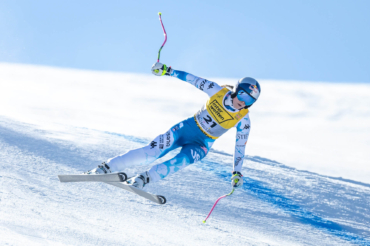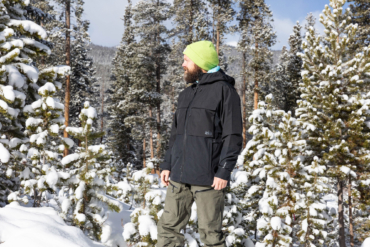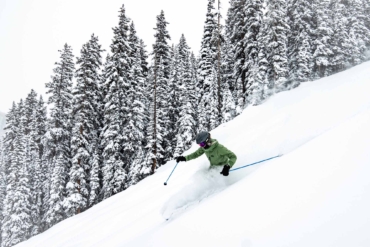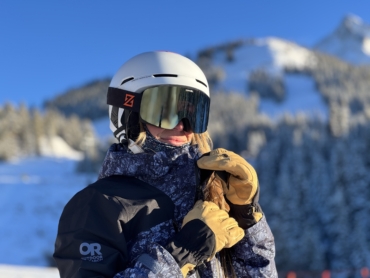After years of tinkering, I have arrived at something I call simply “The GearJunkie Winter Bike.” This year’s bike is an esoteric beast: a single-speed racer with studded tires and no traditional brakes.

Readers of this publication know my love for bikes as well as wintertime in the outdoors. I combine the two passions each year when the snow falls by building a custom ride specifically made for icy city streets. (See my 2013 custom ride in the post from last year, “Made-for-winter ‘Snow Fixie’ Bike.”)
This year, I used a Madison from Schwinn as the base and customized it from there. The Madison is a mid-price ($620) single speed urban bike from Schwinn. It has a Chromoly steel frame and comes stock with a 46 × 18t drivetrain.
While the Madison is a good base, I stripped off some of the factory parts and also put on new winter tires, a better saddle, and different handle grips. The end result is a solid, stealthy urban winter machine.
While I don’t recommend everyone mimic this build, the bike for me has served as an ultimate winter commuter. I ride 15+ miles most days through ice and snow and in temps from 20 degrees F to below-zero on the worst of weeks.
This special bike lets me stay in shape, commute fast to my office, and have fun on often-iffy winter roads while doing it.

Breakdown of stand-out features and parts
1) One Speed — Shifters, cables, derailleurs, cogs, and other accompanying parts included in a common geared bike get clogged with snow and road grime on a winter ride. Road salt destroys components. I prefer the simplicity of a single-speed bike, and in my home city of Minneapolis, the hills are small so extra gears are often not needed. The simplified setup is easier to clean, too, making maintenance as quick as a chain lube with little else to fuss about.
2) Fixed-Gear — The heart of this bike is its fixed-gear drivetrain, meaning there is no freewheel and a rider cannot coast. The pedals are locked in motion with the chain and wheels as they spin. Because of this, you can control acceleration as well as deceleration (braking) with your feet. The pedals are your interface for all motion on a fixed-gear, and I find the setup works on winter roads where I need ultimate control.
3) No Traditional Brakes — I told you this bike was weird! But once you master a fixed-gear bike, regular brakes are not needed. Instead, with the right skill back-pressure on the pedals slows you, and it’s easy to skid to a stop on snowy roads. Caveats to this setup are many, and you must make sure you can control a fixed gear before considering it for winter. Also in some municipalities, normal brakes are required by law.
4) Studded Tires — Metal studs on the road add grip when it’s icy. I roll with the Xerxes tires from the Minnesota-based 45NRth brand. The rubber is laced with 140 studs that I can literally hear cutting into the ice and snow as I ride. A raised rubber tread in the middle on these 700×30 tires lets you roll smoothly on asphalt where studs are not needed. (You can also raise or lower the air pressure to engage the studs less or more as per conditions of the day.) The Xerxes tires cost about $75 apiece but are worth the expense if you can stay upright on the road.
5) Rear Fender — Keep the road spray off your back with a simple plastic fender. Mine cost about $15 and clamps onto the seat post with no fuss. I wear waterproof pants and a shell jacket for winter riding, and I fully expect to get messy on warmer days. But the rear fender helps alleviate the main source of spray. (Note: I do not use a front fender in the winter months; I find it superfluous for all but the sloppiest of winter days.)
6) Lights — Mount a strong-blinking red light on the back of the bike. It’s often dark riding home in the winter, and drivers are not expecting bikers. I overdo it on the lights, including a blazer white LED on my helmet facing forward and at least one red blinker on my bike and backpack. The small light in this photo is the Serfas Thunderbolt, an LED unit that pumps out 90 lumens of red-blinking glow for better visibility from behind.
7) Reflective Touches — Beyond battery-powered lights, reflectivity is a savior on dark streets. I wear a backpack with reflective patches as well as outerwear made to glow when high beams hit my back. I also put a pad on the top bar of my winter bike (pictured). The gaudy green/yellow cylinder adds some strange style along with good reflectively that glints in the night.
Be safe out there! Winter riding can be dangerous on many fronts. Be sure to avoid roads clogged with cars. I alternate my city routes to skip traffic on dark, icy nights. I try and stay on trails with no cars.
But with my custom winter bike, I feel safer and more in control than ever. The tires dig in, the lights keep me visible, and the single-speed is dialed to the gearing I need to spin fast on the cold winter road.






